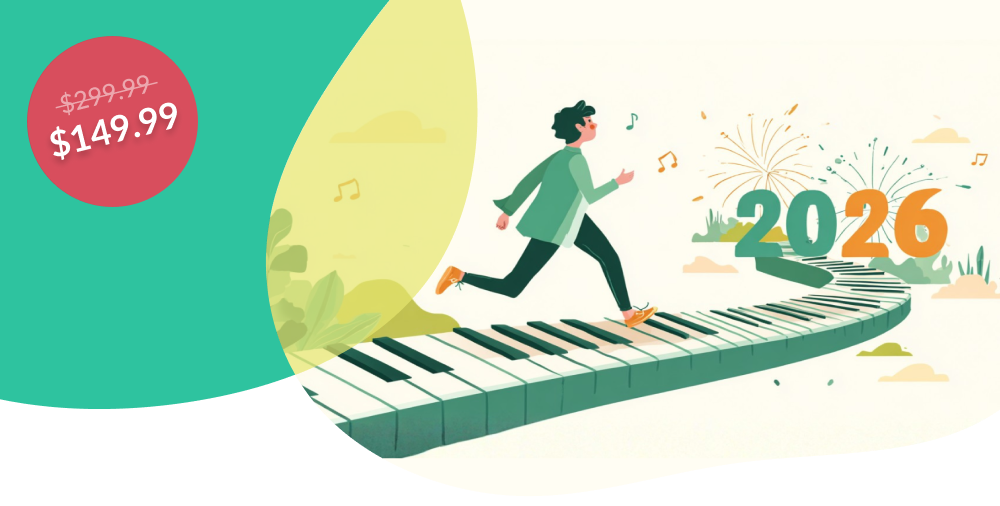Composing music is one of the most enjoyable and rewarding experiences you can have as a musician. Every beginning piano student should try composing piano music. However, learning how to compose music on piano can be a little overwhelming at the beginning. You might ask yourself questions like “where do I start?” or “what should I compose?” that feeling of uncertainty might leave you paralyzed!
Fortunately, there are some simple strategies we can call upon to make learning how to compose piano music much easier and loosen up some of those tight and possibly restrictive feelings around our creativity. Read on for some ideas to get you composing today!

Don’t overthink it
Beginning piano students often seem overwhelmed when learning how to compose music on piano. They get caught up in their minds and allow their uncertainty to cloud their creativity.
Don’t bother with judgment
Do not overthink it when learning how to compose piano music. Do not waste any time judging what you compose. Do not worry if you do not know how to read piano sheet music very well. If you approach your first compositions like doodles on the margins on a piece of notebook paper or a scribble on the back of a napkin, you will be on the right track.
Just a simple sketch
Your favorite composers sketch out their ideas, constantly tweaking and reiterating their ideas so that they can distill the essence of a melody or chord progression. The first sketches of Beethoven’s Fifth Symphony were far from the finished version we know today. Keep this in mind and don’t get hung up over starting a small musical idea.
Start with some basics
An easy way to break the compositional ice is to start with a basic element. There are four fundamental elements of music: chords and harmony, melody, rhythm, and dynamics. A simple strategy to start composing piano music is to choose one and go from there.
Chords and harmony
Perhaps the easiest way to start composing piano music is to begin with a chord progression. Grab a couple of basic piano chords and smash them together. Do you like how C major sounds with A minor? Many people do.
What about throwing in a D minor after you repeat the progression twice? Simple and easy.
Play that entire progression three times and then move to a G major chord to round it out. There you go! You have a basic chord progression to start your song:
C major – A minor | C major – A minor | D minor | x 3
G major | G major | repeat
If you approach writing chord progressions in this way, you will have no problem learning how to compose a song on piano.
Weave in a melody
Some students find it easier to start composing piano music with a melody as the starting point. If you feel comfortable writing the notes in the treble clef, you may enjoy notating your melodies on music notation paper.
Composing melodies is not as exact a science as learning how to compose piano music with chords. But, there here are some basic pointers:
- Think lyrically. Almost every melody in pop music is based around lyrics.
- Give enough space. If you plan to sing your melody, you will need space to breathe!
- Use small groups of notes called motifs. Powerful melodies are built around small chunks of notes that repeat and morph.
- Keep it simple!
The rhythm ties it all together
Sometimes students find it easiest to begin with the rhythm when learning how to compose a song on piano. It may be simple to write a basic chord progression, or sing a simple melody. But, if you do not know what the rhythm will feel like or what the drum beat will sound like, you might have trouble locking down a solid concept.
Using some type of metronome or drum machine is extremely useful when composing piano music. For example, if you know you want to write a fast song, that means you will probably have fewer chords and a melody with longer notes.
On the other hand, maybe you will have a fast moving melody to match your fast rhythm. If you want to try composing piano music at a slower tempo, then you will probably be able to fit in more chords and maybe a faster melody to match.
Either way, identifying what type of rhythm you want your song to have before you begin writing any chord progressions or melody can help you to break through any creative blocks you might experience.

Copy your heroes
There is no shame in copying your heroes when you are learning how to compose piano music. In fact, it is almost necessary at some level to study and learn the songs of your biggest musical influences. That way, you learn the underlying architecture of songs you actually enjoy.
Here is a simple strategy:
- Find a song you truly love and want to learn
- If it is a song in the Skoove repertoire, all the better. You will be able to learn it easily with the Skoove app.
- Learn all the components of the song. What is the chord progression? What is the melody? What is the rhythm? What does it look like on the grand staff?
- Once you can play the song fluently and understand the fundamentals of the chords, melody, and rhythm, start to change little bits of the song.
- If the chord progression is D minor – A minor – E minor, try shifting the chord progression to E minor – A minor – D minor, or some other variation. Then shift the melody and rhythm to match this change.
- Or, start shifting the melody first. Take the chord progression you enjoy and try to write a new melody for it. Musicians call this a “contrafact” and it is a great tool to use to learn how to compose a song on piano.
Conclusion
Learning how to compose music on piano is an awesome experience that all beginning students should try. However, some students may feel overwhelmed or stuck when trying to compose piano music for the first time. There are some simple strategies we can use to break through these creative blocks including:
- Keep it simple
- Start with some basics: choose chords, melody, or rhythm
- Copy your heroes, then make changes!
Try out some of these strategies and see how they work for you! Remember, that Skoove offers many great lessons across a wide range of styles. If you are interested in learning some piano basics in a fun and engaging way, try out a 7 day trial with Skoove this week!
Author of this blog post

Eddie Bond is a multi-instrumentalist performer, composer, and music instructor currently based in Seattle, Washington USA. He has performed extensively in the US, Canada, Argentina, and China, released over 40 albums, and has over a decade experience working with music students of all ages and ability levels.















